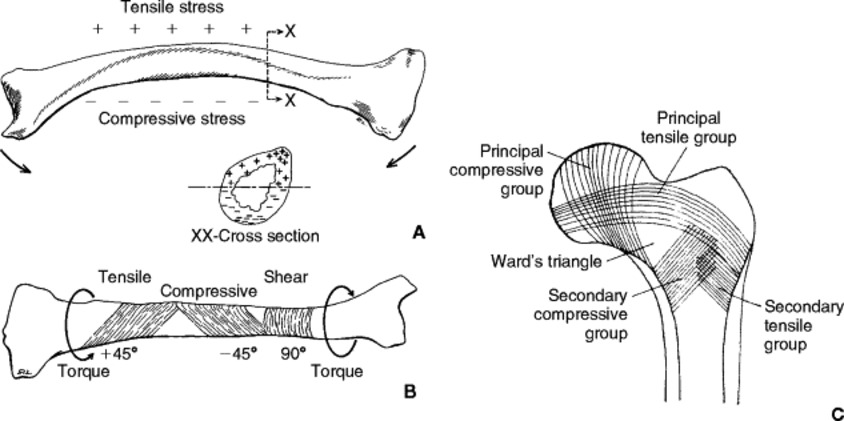Newton’S Three Laws Of Motion
The human body is continually subjected to external and internal mechanical forces that tend to produce structural deformation of tissue. These forces, which include gravity, muscle activity, and ground reaction forces (i.e., the result of foot and ground interaction during locomotion) are resisted in the body by bone, muscle, and ligament, as well as other soft tissues. Loads, or external forces, can be individual or a combination of compression, torsion, translation (i.e., shearing), and tensile loading. Understanding these forces and the ways they affect the hard and soft tissues of the musculoskeletal system is essential for chiropractors, who are directly concerned with the restoration of balance and mobility to the spinal column and other musculoskeletal structures.
This chapter introduces the key terms and concepts of biomechanics that chiropractors deal with throughout their careers. It complements Chapter 4 (Spinal Anatomy), adding detail on the qualities and functions of the various tissues that make up the musculoskeletal system.
TYPES OF LOADING, STRESSES, AND STRAINS
Translation and Shearing
Translation occurs when all particles in a body move in parallel at a given time. When one body undergoes translation with respect to another adjacent body, shearing forces result. An example would be two adjacent vertebrae. If a load is applied to a structure and no rotation occurs, then shearing can result (Fig. 6-1).
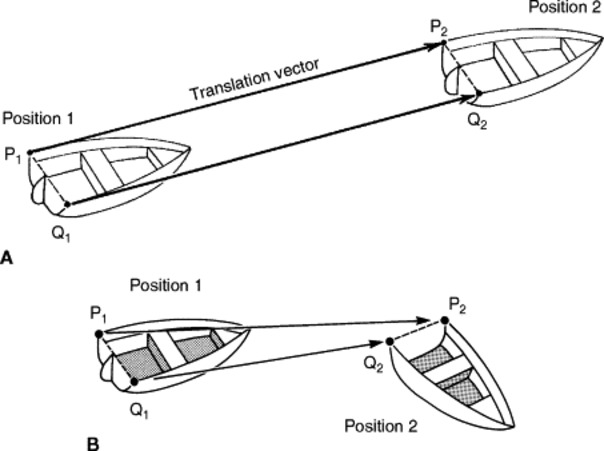 |
| Fig. 6-1 A, Translation. When a body (boat) moves such that a line P1Q1 in it moves parallel to itself, the body is said to translate. Lines joining the same point on the body in two different positions (e.g., line P1P2 and Q1Q2) are called the translation vectors. The translation vectors of all points on the body are always equal and parallel to each other, indicating translation of the body. B, Rotation. A body is said to rotate when a line in it does not move parallel to itself. In the boat, the line P2Q2 is not parallel to P1Q1. (From Panjabi MM, White AA: Biomechanics in the musculoskeletal system, New York, 2001, Churchill Livingstone.) Churchill Livingstone |
For example, if the left hand is tightly wrapped around T12 and the right hand around L1 on a plastic model of the spinal column and an attempt is made to pull T12 while not allowing L1 to move, then a shearing force at the T12-L1 disk will occur. It is the sagittal orientation of the T12-L1 facets that permits this type of movement (Fig. 6-2). Shearing, which usually occurs in combination with other forces, can cause a fracture-dislocation. The orientation of the midcervical facets (Fig. 6-3) favors fracture-dislocation in car accidents involving violent forward flexion of the head. Fortunately, soft tissues such as the annulus fibers of the intervertebral disk contribute resistance to shearing forces and thus to the clinical stability of the spine.
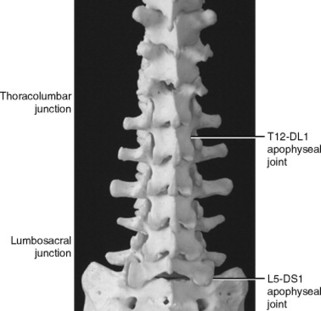 |
| Fig. 6-2 Posterior view of the thoracolumbar and lumbosacral junctions. The transition in the orientation of the facet surfaces within the zygapophyseal joints between the two junctions is visualized. Compare sagittal orientation of T12-L1. (From Neumann DA: Kinesiology of the musculoskeletal system: foundations for physical rehabilitation, St Louis, 2002, Mosby.) |
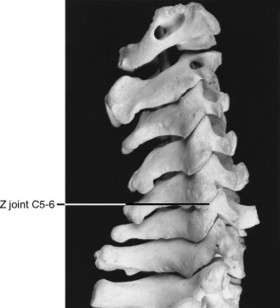 |
| Fig. 6-3 Lateral view of the cervical spine. The angulation of the facets at the zygapophyseal joints is visualized. (From Herzog W: Clinical biomechanics of spinal manipulation, Philadelphia, 2000, Churchill Livingstone.) Churchill Livingstone |
Compression, Tensile Loading, and Distraction
Flexion is accompanied by compression of anterior structures and tensile loading (i.e., elongation or loading in the vertical axis) of posterior structures (Fig. 6-4). Compression in the spine resulting from flexion is possible and largely due to intervertebral disks that extend the height between the vertebrae. The spine is susceptible to compressive loads, either in single episodes involving high forces or by constant low-force compression. If flexion is violent, as in a car accident, then anterior compression injuries and posterior tearing of the restraining soft tissue is possible. Significant compression (loads greater than 600 pounds per square inch [psi]) of vertebral end plates and bodies can result in compression fractures or herniation of discal material through the vertebral end plate. Distraction and tensile loading are not common but can occur in an automobile accident when the seat belt restrains the trunk (Figs. 6-5 and 6-6).
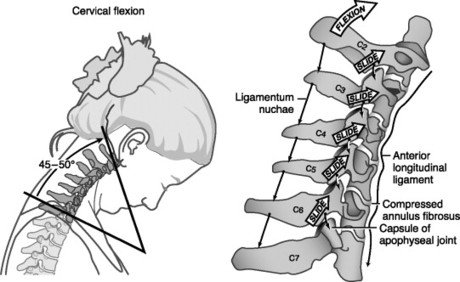 |
| Fig. 6-4 Flexion of the cervical spine. Flexion slackens the anterior longitudinal ligament and increases the space between the adjacent laminae and spinous processes. Elongated and taut tissues (thin black arrows) and slackened tissue (wavy black arrow) are indicated. (From Neumann DA: Kinesiology of the musculoskeletal system: foundations for physical rehabilitation, St Louis, 2002, Mosby.) |
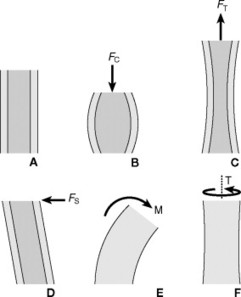 |
| Fig. 6-5 Effects of different types of forces acting on a solid object. A, No forces acting; B, compressive force FC; C, tensile force FT; D shear force FS; E, bending moment B; F, torsional moment, or torque T. (From Adams MA et al: The biomechanics of back pain, Edinburgh, 2002, Churchill Livingstone.) Churchill Livingstone |
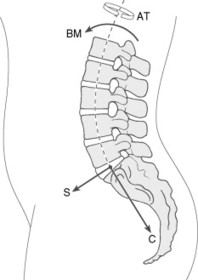 |
| Fig. 6-6 Component forces acting on the lumbar spine. C, Compression; S, shear; BM, bending moment in the sagittal plane; AT, axial torque. In three dimensions a lateral shear force and lateral bending moment could also occur. (From Adams MA et al: The biomechanics of back pain, Edinburgh, 2002, Churchill Livingstone.) Churchill Livingstone |
Extension is accompanied by compression of posterior structures and tensile loading of anterior structures. If violent, it can result in injuries opposite to those observed in flexion. Intervertebral discs are largely responsible for permitting compression and the resultant extension (Fig. 6-7).
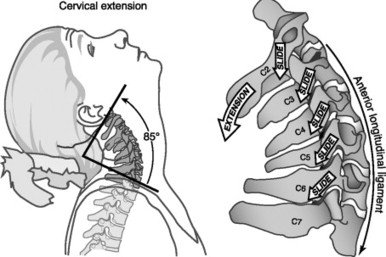 |
| Fig. 6-7 Extension of the cervical spine. The extension stretches the anterior longitudinal ligament and decreases the space between the adjacent laminae and spinous processes. (From Neumann DA: Kinesiology of the musculoskeletal system: foundations for physical rehabilitation, St Louis, 2002, Mosby.) |
If forced, lateral flexion loading can cause injuries similar in pattern to those observed in forced flexion—compressive injuries on the side toward lateral flexion and tensile loading or distraction injuries on the side opposite lateral bending. As occurs in flexion and extension, the disks contribute to the degree of lateral bending that is permitted.
Rotation or Torsional Loading
Rotation or torsional loading occurs when all particles in a body move in concentric circles or arcs. The vertebral motion segment is far more resistantto compression, distraction, and bending than it is to rotation. Rotation or torsion is potentially damaging because it results in shearing, tensile, and compressive forces combined within the material or body undergoing rotation. Torsion is resisted by the ribs in the dorsal spine and by the more sagittal-oriented facet joints in the upper lumbar spine. At the L5-S1 joints, the iliolumbar ligaments provide resistance to torsion.
Stress
Stress is the force per unit area and involves internal forces within a body that arise as a result of external loads applied to the body. Internal resistance to an externally applied load is inherent in any tissue. The degree to which loading is resisted depends on the material, its size, and the load applied. Low levels of tissue stress maintained over a long period or high levels of stress applied over a short period can result in tissue damage. Stress can result in deformation of a body or strain. Deformation of a body can be temporary or permanent (Fig. 6-8).
